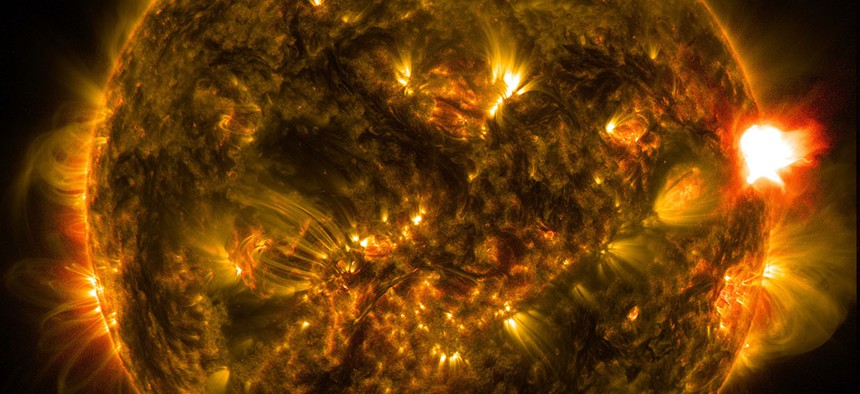Officials Worry US ‘Falling Behind’ in Race to Prepare for Electromagnetic Pulse Attacks

The first notable solar flare of 2015, as observed from NASA's Solar Dynamics Observatory. NASA/AP
Congress wants to ensure federal agencies are doing their best to prepare for them.
Electromagnetic pulses and violent space weather outbursts might seem like national security threats straight out of science fiction. But the House Homeland Security Committee wants to ensure federal agencies are doing their best to prepare for them.
During an Oversight and Management Efficiency subcommittee hearing Tuesday, legislators reviewed the possible ramifications that a man-made EMP weapon, detonated nuclear device or even space weather phenomena could have on the nation’s power grid. While seemingly remote, the threats drew comparisons to the Japanese attack on Pearl Harbor in 1941 and the Sept. 11 terrorist attacks.
While unlikely, being unprepared could mean loss of life and could be devastating to the nation’s telecommunications and power grid, lawmakers said. One report estimates the potential cost of a large-scale solar storm, emanating from a large release of energy by the sun, could exceed $2 trillion and leave large portions of the population without power for months or longer.
“Investigations determined the attack on Pearl Harbor was possible, not probable,” said Rep. Barry Loudermilk, R-Ga. “Same thing for 9/11.”
» Get the best federal technology news and ideas delivered right to your inbox. Sign up here.
In fact, small-scale solar events have occurred before and caused damage to modern critical infrastructure. In 1989, a geomagnetic storm shut down the Quebec Hydro Electricity Network for days and ultimately cost nearly $2 billion in damages.
Rep. Earl Carter, R-Ga., said EMP and space weather ought to be treated “as a top priority,” but questioned whether federal officials were taking it seriously, highlighting a March report by the Government Accountability Office. That report said there wasn’t a single entity within the Homeland Security Department focused on electromagnetic risks.
The White House’s National Space Weather Action Plan, published in October, establishes responsibilities for agencies in the event of space weather-related phenomena, but electromagnetic risks aren’t addressed explicitly in that policy.
“I wouldn’t characterize it as a low priority,” said Brandon Wales, director of DHS’ Office of Cyber and Infrastructure Analysis. “The Space Weather Action Plan that applies across the agency demonstrates the department is extremely focused on doing what it can.”
In testimony Tuesday, Chris Currie, GAO’s director of Homeland Security and Justice, said DHS and the Energy Department were not duplicating work and had addressed many of GAO’s March recommendations.
But while DOE and DHS are working together to determine what EMP events would cause the most damage to power systems, Currie told the subcommittee there was otherwise “little partnering between agencies.”
More industry engagement will also be important, he said, as the nation’s telecommunications and power grid infrastructure is chiefly owned by industry, not the government.
Included among that infrastructure are some 55,000 power substations across the country, any of which could require up to a year of lead time to replace. A single solar storm could knock out hundreds of them at once.
“The industry argument is that we can’t protect each of these,” said Joseph McClelland, director of the Federal Energy Regulatory Commission’s Office of Energy Infrastructure.
McClelland argued assets should be focused around functionality – prioritizing the stations that would be needed to provide skeletal services to urban areas, for example.
In any case, McClelland suggested more collaboration is necessary in the near future if the U.S. wants to mitigate against sophisticated electromagnetic weaponry or Mother Nature gone mad.
“The United States is falling behind in EMP and space weather preparedness,” McClelland said.



